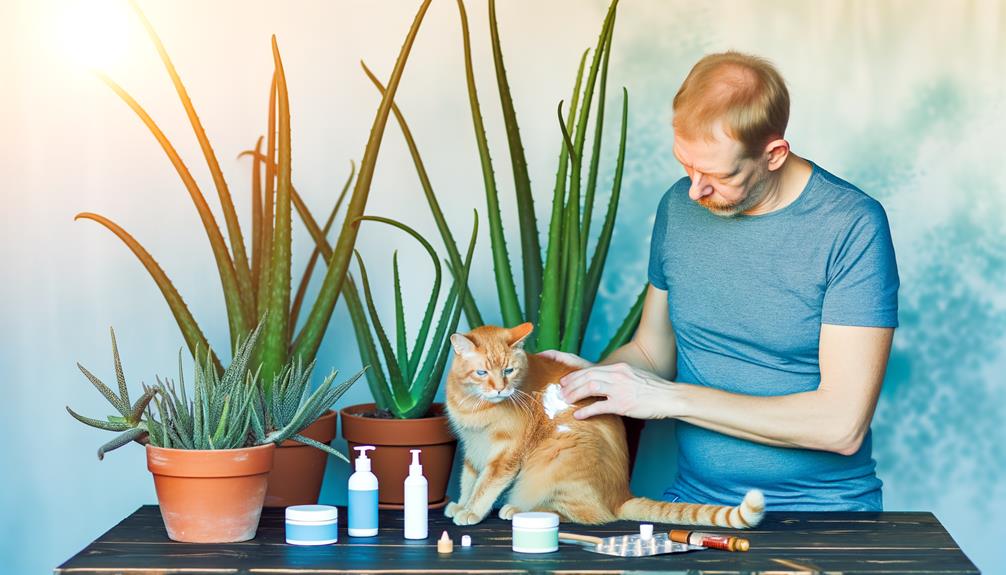When your cat starts suffering from hot spots, it can be quite distressing. You might notice your feline friend constantly licking or scratching a particular area, causing more irritation. Treating hot spots involves several steps, starting with shaving the fur around the affected region to get a clear view and facilitate cleaning. But what exactly should you use to clean it, and how do you prevent your cat from making it worse? The answers lie in understanding both the symptoms and the underlying causes, setting you on the right path to effective treatment.
Understanding Hot Spots
Understanding hot spots, also known as acute moist dermatitis or pyotraumatic dermatitis, is vital for effective treatment. These superficial skin infections arise from excessive licking, chewing, or scratching, leading to significant inflammation and discomfort. Typically, hot spots manifest as well-defined, red, weepy, and raw areas on the skin, often exacerbated by hot, humid weather, though they can occur year-round.
It's important to recognize that hot spots are more prevalent in long-haired cats due to trapped irritants in their dense fur. The initial presentation includes moist, itchy skin which can rapidly deteriorate, resulting in hair loss and pus formation. These signs not only cause your cat immense discomfort but also increase the risk of secondary infections.
Quick veterinary intervention is essential if the hot spot does not show improvement within 24 hours. Persistent or worsening hot spots may indicate a more serious underlying issue that requires prompt and appropriate treatment. A detailed veterinary assessment will help identify the root cause, whether it's an allergy, parasite, or another irritant, and guide the most effective treatment plan.
In addressing hot spots, managing the primary issue is fundamental. This might involve topical or systemic antibiotics to combat secondary infections, anti-inflammatory medications to reduce inflammation, and possibly modifications in grooming or environmental management to prevent recurrence. Understanding and addressing hot spots thoroughly guarantees not just symptomatic relief but also long-term health and comfort for your cat.
Symptoms of Hot Spots
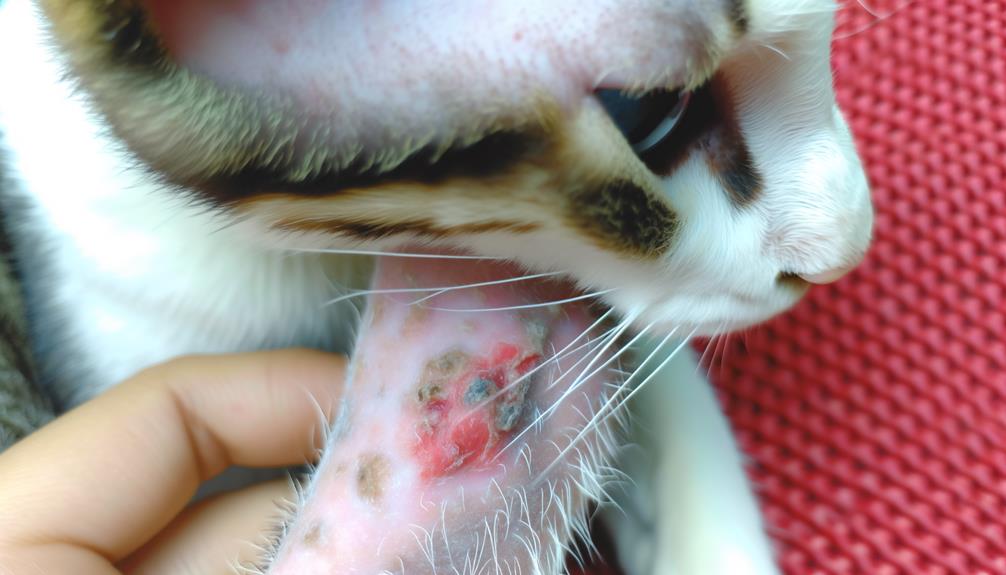
When identifying hot spots on your cat, you'll notice red, hairless patches of skin, often moist and inflamed, commonly located on the face, belly, or base of the tail. These areas may ooze pus and feel warm, indicating a secondary infection that can worsen if untreated. Look for signs such as excessive itching and grooming, as these behaviors can exacerbate the lesions, leading to more severe skin infections and significant discomfort for your cat.
Initial Signs to Watch
Spotting the initial signs of hot spots on your cat can be essential for timely treatment. Hot spots, also known as acute moist dermatitis, often present with itchy skin that is inflamed and red. You might notice areas where the skin appears weepy or moist, a sign that the underlying tissue is irritated. Hair loss around these regions is common, and the affected skin may feel warm to the touch, indicating inflammation.
A critical indicator of hot spots is excessive grooming behavior. Cats tend to lick, chew, or scratch the itchy areas, which can exacerbate the condition. This behavior often leads to matted fur around the lesion, further obscuring the severity of the infection. As the condition progresses, these lesions can develop into oozing, open sores, greatly raising the risk of secondary bacterial infections.
Additionally, your cat may display sensitivity or even pain when you touch the affected regions. This sensitivity often amplifies their grooming efforts, creating a vicious cycle of irritation and discomfort. Recognizing these initial signs early can help you address the problem before it escalates, ensuring your cat receives the care they need to recover swiftly.
Advanced Symptoms Indicated
As hot spots progress, the symptoms can become more severe and complicated, requiring immediate attention. Initially presenting as moist, itchy, and inflamed skin, hot spots on cats can rapidly escalate if not promptly addressed. You'll notice considerable hair loss around the affected area, often accompanied by the formation of pus, which exacerbates the discomfort and moisture, making scratching almost irresistible for your cat.
Commonly found on the face, belly, and base of the tail, these lesions can feel warm to the touch due to inflammation. As the condition worsens, the once weepy areas can develop into crusty, painful lesions, greatly increasing the risk of secondary infections. If left untreated, these infections can complicate the clinical picture, necessitating more intensive treatment.
Matted fur around the hot spot can obscure the severity of the infection, so it's essential to examine the area closely for signs of redness and irritation. Early detection and treatment are critical to prevent the condition from deteriorating. Consult a veterinarian promptly to address the underlying causes and establish an effective treatment plan, ensuring your cat's skin heals and the painful symptoms are alleviated.
Causes and Risk Factors

Fleas, mites, and ticks, common external parasites, are primary culprits behind hot spots on cats, inducing substantial skin irritation and persistent itching. These parasites cause your cat to scratch and bite at their skin, leading to raw, inflamed areas known as hot spots. However, these aren't the only causes. Allergies, particularly flea allergies, can trigger severe skin irritation. Food sensitivities also play a role, with certain proteins or additives causing allergic reactions that manifest as skin issues.
Long-haired cats are especially susceptible to hot spots. Their dense fur traps moisture and irritants close to the skin, creating an ideal environment for infections. This makes grooming and regular checks essential for these breeds. Overgrooming, whether due to pain, discomfort, or behavioral issues like stress and anxiety, can exacerbate the condition. Cats may lick or chew at affected areas, further aggravating skin damage and promoting the development of hot spots.
Environmental factors such as hot and humid weather also contribute considerably to the occurrence of hot spots. These conditions foster a breeding ground for bacteria and other pathogens, increasing the likelihood of skin infections. High humidity can keep your cat's skin damp, and combined with heat, this can quickly turn into a hot spot.
Understanding these risk factors and causes is essential for prevention and management. By addressing parasites, managing allergies, and maintaining a stress-free environment, you can considerably reduce your cat's risk of developing hot spots. Regular grooming, particularly for long-haired cats, and monitoring for signs of overgrooming can also help keep your feline friend healthy and comfortable.
Diagnosis Methods
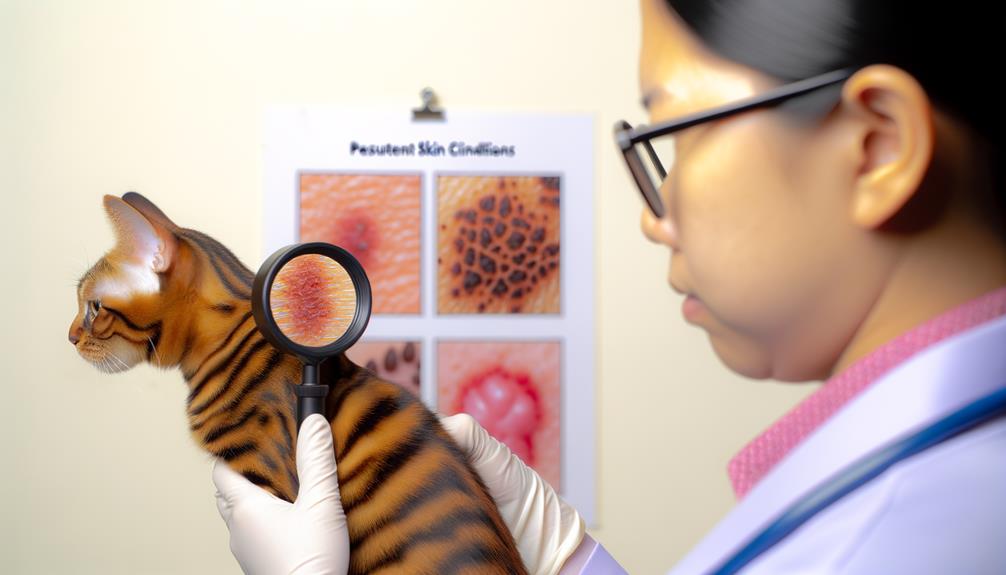
To accurately diagnose hot spots in your cat, a veterinarian will begin with a thorough physical examination, visually evaluating the affected area and its symptoms. They'll review your cat's medical history to identify any previous skin issues, allergies, or conditions that might contribute to the problem. Diagnostic tests such as skin scrapings or cytology may be necessary to rule out underlying infections or parasites, ensuring an extensive understanding of the underlying causes.
Physical Examination Techniques
A thorough physical examination by a veterinarian is the cornerstone of diagnosing hot spots in cats. During the examination, the veterinarian will visually assess the affected skin and surrounding areas for signs of inflammation, redness, hair loss, and any discharge. These symptoms are indicative of hot spots. The vet will also review your cat's medical history, focusing on previous episodes of hot spots and any known allergies, to create an accurate diagnosis.
The table below outlines the core components of this examination:
| Component | Description | Purpose |
|---|---|---|
| Visual Assessment | Check for redness, inflammation, hair loss, discharge | Identify hot spots and their severity |
| Medical History | Review of past episodes, known allergies | Contextualize current condition and inform diagnosis |
| Skin Condition Check | Inspect for other skin conditions | Rule out other dermatological issues |
| Diagnostic Tests | Skin scrapings, cultures | Confirm hot spots and rule out infections |
The location of the hot spots can provide clues about potential underlying causes, such as external parasites or allergies. Additional diagnostic tests, like skin scrapings or cultures, may be required to rule out other skin conditions or infections. This detailed examination will guide the veterinarian in formulating an effective treatment plan tailored to your cat's specific needs.
Identifying Underlying Causes
Why is identifying the underlying causes of hot spots on cats so important? Understanding the root cause is essential for effective treatment and prevention. A thorough approach includes:
- Detailed physical examinations by a veterinarian to assess severity and presence.
- Diagnostic tests such as skin scrapings, cytology, and cultures to identify infections or parasites.
- Reviewing medical history, including previous hot spots and known skin allergies.
- Evaluating lesion locations to differentiate between potential triggers like flea or environmental allergies.
- Considering factors such as age, breed, and lifestyle to pinpoint underlying causes.
Your veterinarian will start with a detailed physical examination to identify hot spots on your cat and evaluate their severity. This examination is followed by diagnostic tests like skin scrapings, cytology, and cultures to detect any infections or parasites contributing to the problem. Reviewing your cat's medical history, including any previous hot spots and known skin allergies, is vital for an accurate diagnosis.
The location of the hot spots can offer valuable clues. Lesions on the belly might indicate flea allergies, while those on the face could suggest environmental allergies. Factors such as your cat's age, breed, and lifestyle (indoor vs. outdoor) are also considered to guide targeted diagnostic approaches. Identifying underlying causes is key to managing and preventing future skin issues.
Treatment Options
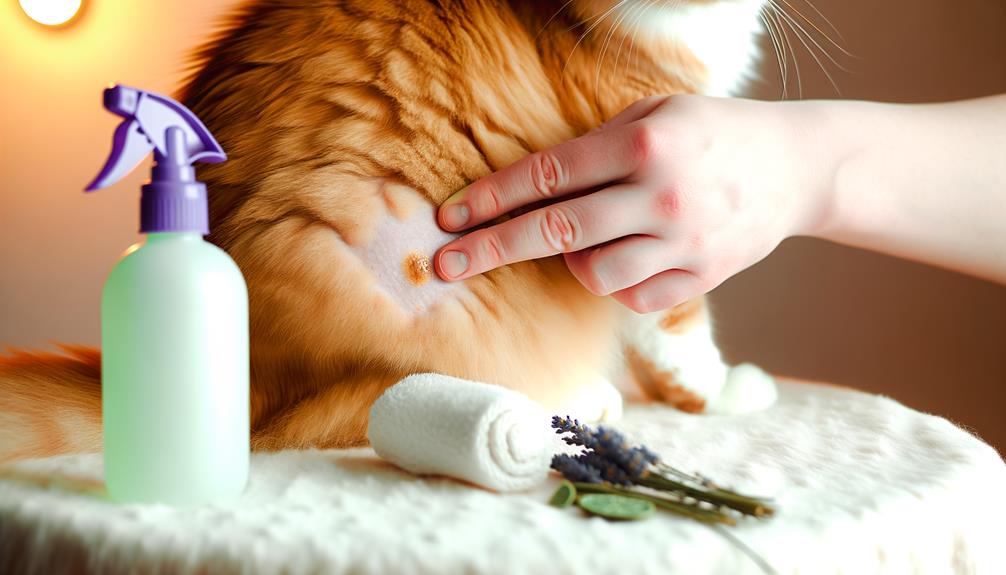
When addressing hot spots on cats, initial treatment options focus on both visibility and hygiene. Shaving the fur around the affected area is an essential first step in hot spot treatment. This not only improves visibility but also facilitates an effective cleaning procedure. Use a non-toxic antimicrobial solution to clean the hot spot, removing debris and bacteria to reduce the risk of infection.
Following the cleaning procedure, topical treatments are vital. Apply antibacterial ointments to combat potential bacterial contamination and anti-inflammatory creams to soothe the skin. These topical treatments promote the healing process by reducing inflammation and preventing further irritation.
In cases where the hot spot is greatly infected, oral antibiotics may be necessary for systemic treatment. These medications help eradicate deeper bacterial infections that topical applications alone can't address. Your veterinarian will prescribe the appropriate antibiotics based on the severity and type of infection present.
To prevent your cat from aggravating the area, it's often recommended to use an Elizabethan collar or a protective garment. These devices prevent licking and scratching, which can impede the healing process and introduce additional bacteria to the site.
Each step in this treatment regimen is designed to guarantee a thorough approach to healing. By emphasizing initial visibility and hygiene, employing targeted topical treatments, and considering systemic treatment when necessary, you can effectively manage and treat your cat's hot spots. This multi-faceted strategy enhances the likelihood of a swift and complete recovery, minimizing discomfort and facilitating a smooth healing process for your feline companion.
Prevention Strategies
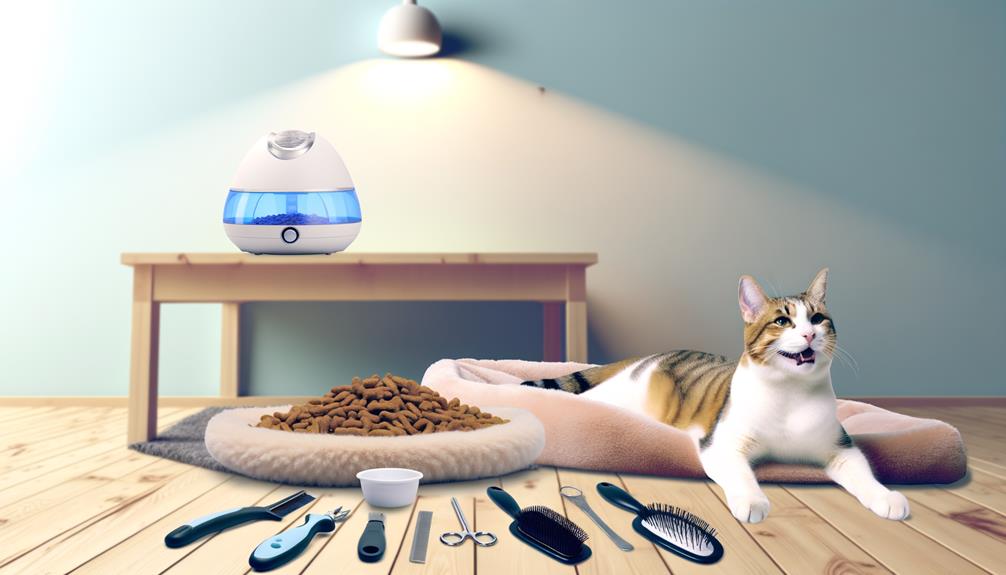
How can you effectively prevent hot spots on your cat? Implementing a thorough prevention strategy is vital to safeguard your feline friend from this painful condition. Here are evidence-based strategies to take into account:
- Flea and tick prevention: Regular treatments are essential. Parasites like fleas and ticks are common triggers for hot spots, causing considerable skin irritation.
- Environmental enrichment: Reduce your cat's stress by providing interactive toys and engaging playtime. This minimizes excessive grooming behaviors that can lead to hot spots.
- Clean and well-groomed coat: Consistently maintaining your cat's coat, especially for long-haired breeds, helps reduce moisture and irritation that can contribute to hot spots.
- Allergies: Work with your veterinarian to identify and manage any allergies through testing and potential dietary adjustments. Controlling allergies can prevent skin flare-ups.
- Regular veterinary check-ups: Routine visits to the vet allow for early detection of skin issues and timely intervention, preventing the escalation to hot spots.
Consistent flea and tick prevention is paramount. Fleas and ticks can cause severe irritation, leading to excessive scratching and biting, which are primary contributors to hot spots. Regular treatments can greatly reduce this risk.
Implementing environmental enrichment is another important strategy. Providing interactive toys and regular playtime can alleviate your cat's stress, decreasing the likelihood of compulsive grooming behaviors that lead to skin irritation and hot spots.
Keeping your cat's coat clean and well-groomed is equally important. Regular grooming, especially for long-haired cats, helps prevent the accumulation of moisture and irritation, which are conducive to hot spot development.
Allergy management through veterinary guidance, including allergy testing and dietary adjustments, is vital. Identifying and controlling allergies can prevent the skin flare-ups that often precede hot spots.
Supplementation and Diet

While preventive measures focus on minimizing external triggers, addressing internal factors through supplementation and diet can also play a pivotal role in managing and preventing hot spots in cats. High-quality fish oil supplements, rich in omega-3 fatty acids, can greatly improve skin health and reduce inflammation associated with hot spots. Omega-3 fatty acids are known for their anti-inflammatory properties, making them an essential component of a therapeutic regimen for skin conditions.
Therapeutic hypoallergenic diets are recommended for managing food allergies that may contribute to skin irritations and hot spot development. These specialized diets eliminate common allergens, alleviating the immune response that often triggers skin issues. Regular dietary adjustments based on veterinary advice can support overall health and enhance skin condition, potentially preventing hot spots from occurring.
Incorporating antioxidants, such as vitamin E and zinc, into your cat's diet can bolster skin health and improve the healing process of hot spots. Antioxidants help combat oxidative stress, facilitating better skin resilience and recovery. Always consult with a veterinarian before introducing new supplements or dietary changes to guarantee they meet your cat's specific health needs and conditions.
| Supplement/Dietary Adjustment | Benefit |
|---|---|
| High-quality fish oil | Reduces inflammation, enhances skin health |
| Omega-3 fatty acids | Anti-inflammatory properties |
| Therapeutic hypoallergenic diets | Manages food allergies, reduces skin irritations |
| Vitamin E | Improves healing process, antioxidant support |
| Zinc | Bolsters skin health, antioxidant support |
These dietary strategies, when implemented correctly, can greatly contribute to the management and prevention of hot spots, guaranteeing your cat maintains peak skin health and overall well-being.
